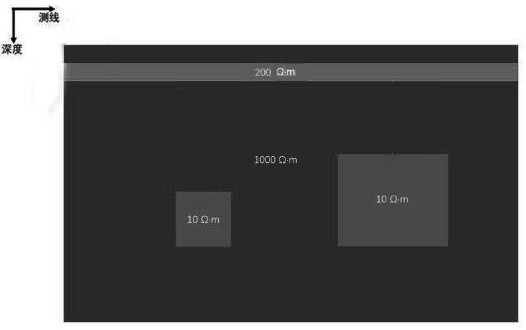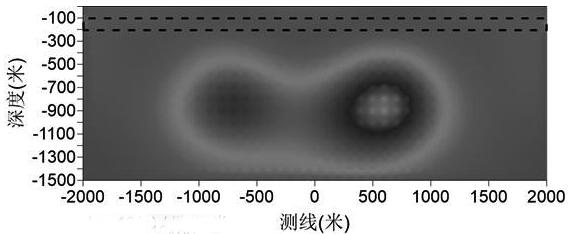Joint inversion method of airborne transient electromagnetic data and airborne magnetotelluric data
A transient electromagnetic and magnetotelluric technology, applied in the field of geophysical exploration, can solve the problems of low aerial MT resolution, shallow aerial TEM exploration depth, and inability to obtain deep electrical distribution of underground media, so as to overcome low depth and improve accuracy Effect
- Summary
- Abstract
- Description
- Claims
- Application Information
AI Technical Summary
Problems solved by technology
Method used
Image
Examples
Embodiment 1
[0037] The joint inversion method of airborne transient electromagnetic data and airborne magnetotelluric data includes the following steps:
[0038] a. Use the nonlinear conjugate gradient inversion method to perform two-dimensional inversion processing on the airborne magnetotelluric data, and obtain a two-dimensional conductivity profile result. The objective function of the inversion is obtained by formula 1;
[0039] Φ(m)=(d-F(m)) T V -1 (d-F(m))+λm T LT Lm formula 1
[0040] Among them, λ is the regularization factor; V is the covariance matrix related to the error vector e; L is the two-dimensional differential matrix related to the model parameter m; d is the observed data; F(m) is the forward numerical simulation value; m is the model parameter vector; T is the transpose of the matrix;
[0041] b. Convert the reciprocal of the resistivity in the two-dimensional conductivity profile results into conductivity, and perform gridding to form regular conductivity grid d...
Embodiment 2
[0051] The joint inversion method of airborne transient electromagnetic data and airborne magnetotelluric data includes the following steps:
[0052] a. Use the nonlinear conjugate gradient inversion method to perform two-dimensional inversion processing on the airborne magnetotelluric data, and obtain a two-dimensional conductivity profile result. The objective function of the inversion is obtained by formula 1;
[0053] Φ(m)=(d-F(m)) T V -1 (d-F(m))+λm T L T Lm formula 1
[0054] Among them, λ is the regularization factor; V is the covariance matrix related to the error vector e; L is the two-dimensional differential matrix related to the model parameter m; d is the observed data; F(m) is the forward numerical simulation value; m is the model parameter vector; T is the transpose of the matrix;
[0055] b. Convert the reciprocal of the resistivity in the two-dimensional conductivity profile results into conductivity, and perform gridding to form regular conductivity grid...
Embodiment 3
[0066] The joint inversion method of airborne transient electromagnetic data and airborne magnetotelluric data includes the following steps:
[0067] a. Use the nonlinear conjugate gradient inversion method to perform two-dimensional inversion processing on the airborne magnetotelluric data, and obtain a two-dimensional conductivity profile result. The objective function of the inversion is obtained by formula 1;
[0068] Φ(m)=(d-F(m)) T V -1 (d-F(m))+λm T L T Lm formula 1
[0069] Among them, λ is the regularization factor; V is the covariance matrix related to the error vector e; L is the two-dimensional differential matrix related to the model parameter m; d is the observed data; F(m) is the forward numerical simulation value; m is the model parameter vector; T is the transpose of the matrix;
[0070] b. Convert the reciprocal of the resistivity in the two-dimensional conductivity profile results into conductivity, and perform gridding to form regular conductivity grid...
PUM
 Login to View More
Login to View More Abstract
Description
Claims
Application Information
 Login to View More
Login to View More - R&D
- Intellectual Property
- Life Sciences
- Materials
- Tech Scout
- Unparalleled Data Quality
- Higher Quality Content
- 60% Fewer Hallucinations
Browse by: Latest US Patents, China's latest patents, Technical Efficacy Thesaurus, Application Domain, Technology Topic, Popular Technical Reports.
© 2025 PatSnap. All rights reserved.Legal|Privacy policy|Modern Slavery Act Transparency Statement|Sitemap|About US| Contact US: help@patsnap.com



